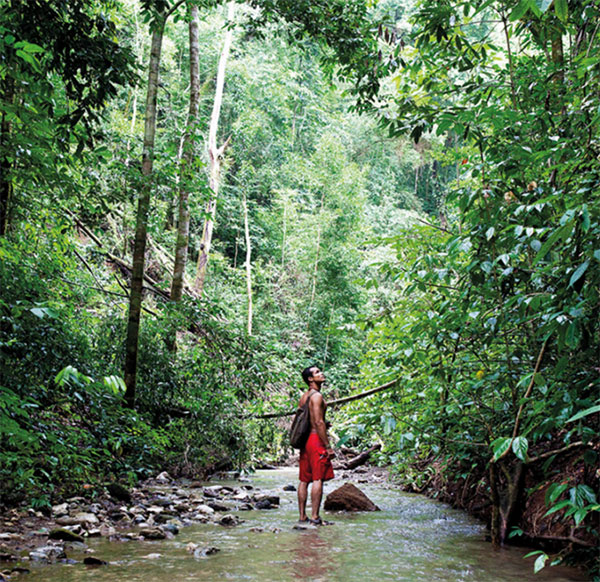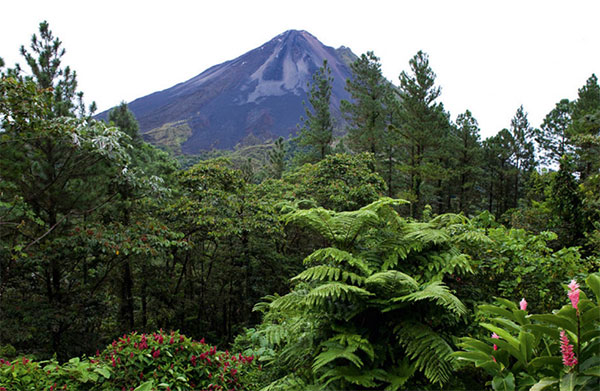MYSTERY OF THE SPHERES
The Diquis region is the site of one of the great pre-Columbian riddles. Spheres made of granite, andesite, and sedimentary stone have been found in their thousands along riverbeds and arranged in cemetery sites. Some are as small as oranges while others weigh up to 14 metric tons and measure up to 2 meters (7ft) in diameter. They are perfectly spherical to within a centimeter or two and are perhaps the finest example of precision stone carving in the ancient world.
The stone spheres are unique – none have been discovered anywhere else in the world. How were they made? How were they shaped to be so perfectly spherical? How were they transported more than 30km (20 miles) from the source of the stone to the ceremonial sites where they were arranged? And what do they mean? Today, they stand mute in their new locations, at the National Museum and in the gardens of expensive homes throughout the Central Valley. You can also see them in their original habitat, Isla del Caño, near Corcovado National Park.
In addition to the enigma of the country’s lithic spheres, there is another pre-Columbian riddle in Costa Rica that continues to perplex historians and archeologists: it is the source of jade for the many pieces found throughout the country, as no jade quarries have ever been found in Costa Rica. Guatemala is believed to be the principal source, although some jade may have come from Mexico.
Many of the objects appear to have been treasured for years, passed down as heirlooms; others seem to have arrived in one form, and to have been re-sculpted to the tastes of their new owners.
One interesting theory holds that some of the jade was brought to Costa Rica by pre-Columbian looters of Mayan burial sites, and this would help to explain the presence of Mayan hieroglyphs inscribed on the stone – which apparently had no value or significance to the Costa Ricans.
The Jade Museum in San José (for more information, click here) has the largest display of jade in the Americas, with more than 6,000 pieces. Many of the pieces are colgantes (amulets or pendants), generally in the form of birds, animals, or humans, but there is a great variety of other exhibits, including notable oddities such as a tooth with a jade inset, and jade breast supports, thought to have been worn by high-ranking women.
Parque Nacional Corcovado
Covering 445 sq km (172 sq miles), Parque Nacional Corcovado § [map] (www.sinac.go.cr; Tue–Sun 7am–4pm) is Central America’s largest lowland Pacific rainforest. It’s the most important sanctuary of biological diversity and endangered wildlife in the country, and one of the most important in the world. Because Corcovado Park is inundated with nearly 6 meters (20ft) of rain a year, it is technically known as a ‘tropical wet forest.’ But the simplicity of that classification belies the ecological complexity of the park. Thirteen distinct habitats here are each characterized by unique assemblages of plants, animals, and topography. Five hundred species of trees – one quarter of all the species in Costa Rica – more than 6,000 kinds of insects, almost 375 species of birds, plus frogs, butterflies, and many of the world’s most endangered and spectacular mammals, including tapirs and jaguars, live in this place.
One of Corcovado’s blessings is its inaccessibility. It is a park only for those who are prepared to make a considerable commitment in time and energy. Camping with your own tent (make reservations well in advance) can be more comfortable than staying at the shabby Sirena facilities. But there are other ways to sample the beauties of Corcovado and the Osa Peninsula, from day trips by boat or charter flights, to accommodations at nearby luxury ecolodges. The ideal time to hike and camp in Corcovado is during the dry season, from December through April. A visit might include a night at each of the three park stations, with days spent hiking from one station to the next. (Stations are joined by trails, each of which requires from three to 10 hours of hiking time.)
A pleasant alternative to sleeping in a tent in Corcovado National Park is to bed down at one of the nearby ecolodges. At one end of the scale is Lapa Ríos (www.laparios.com), set in its own primary forest preserve, with super-comfortable thatched-roof bungalows perched on a hillside overlooking the ocean. It’s as luxurious as it gets here, but like all lodges this far south, it’s off the electrical grid – no TV, no air-conditioning, and few cellular connections.

Walking in the rainforest.
Corrie Wingate/Apa Publications
INSIGHT: MOUNTAINS OF FIRE
Vulcanologists are always busy in Costa Rica, which has five active volcanoes and some 112 dormant and extinct ones. Visitors can explore volcanic peaks and soak in thermal waters.
Costa Rica is a land of earthquakes and volcanoes, where hikers and mountaineering enthusiasts can climb the Central Valley’s four active cones in just two days. Visitors should remember, though, that an active volcano demands respect; proper equipment is essential. Taking a guided tour will ensure the greatest safety. Local people are proud of their explosive geology, and have made Poás and Irazú volcanoes the country’s most visited parks.
The most dynamic and majestic of Costa Rica’s active volcanoes is Arenal, a nearly perfect cone. The 1,633-meter (4,950ft) -high volcano rises above farmlands, adjacent to its own lake, and offered a spectacular show of clouds of gas and steam spewing out of the top. Arenal is still considered active, but it is currently in a resting phase.
Tourists looking for active volcanoes won’t be disappointed, however, as two other ‘resting’ volcanoes have suddenly come back to life – Volcán Rincón de la Vieja, to the northwest of Arenal; and Volcán Turrialba, east of the Central Valley. The latter has been spewing ashes, rocks, and gases since late 2014 and entered a new phase in September 2016, shooting columns of ash up to 4,000 meters (13,000ft) above the crater. Poás Volcano has also shown more activity lately and the popular national park surrounding it sometimes closes temporarily when the sulfurous gas levels get too high.

On its best daytime behavior, Arenal Volcano is pictureperfect with its cone-shaped profile etched against the sky. But the pointy tip often catches passing clouds, disappointing many a photographer.
Corrie Wingate/Apa Publications
Volcano stays
To observe Arenal in true luxury, pamper yourself at the Spanish colonial-style Tabacón Grand Spa Thermal Resort, built on the site of a 1975 hot avalanche deposit that provides the source of heat for the thermal waters.
Although vulcanologists feel there is a risk of future hot avalanches, this hasn’t stopped the Ticos and tourists who flock here to exclaim excitedly over the activity of the volcano and soak their aching muscles. A dip in the waters is also supposedly beneficial for anyone suffering from skin problems and arthritis.
Twelve pools of varying depths and temperatures (the warmest is a sizzling 102°F/38°C), a jacuzzi, hot waterfall, slides, and an individual tub tucked deep in the beautifully landscaped tropical gardens mean fun for everyone from children to senior citizens. A spa offers mud facials in open air bungalows, and the resort has lockers, towel rental, and showers. The hotel here is elegant and expensive. Make reservations well in advance.
If you are on a budget, try the Baldi Hot Springs, though renovations have upped the prices there significantly, or the low-key Titoku Hot Springs, both just west of La Fortuna.